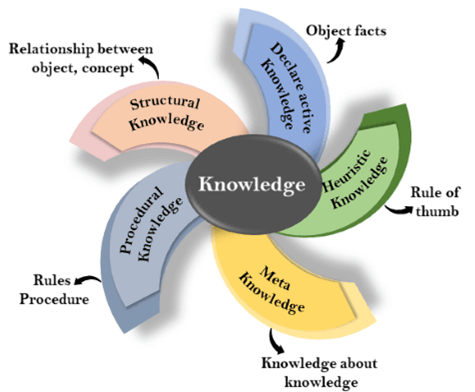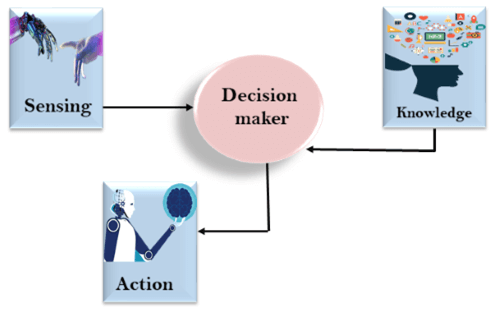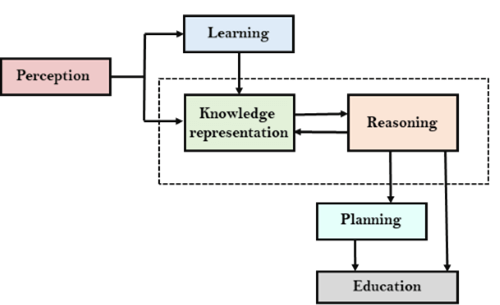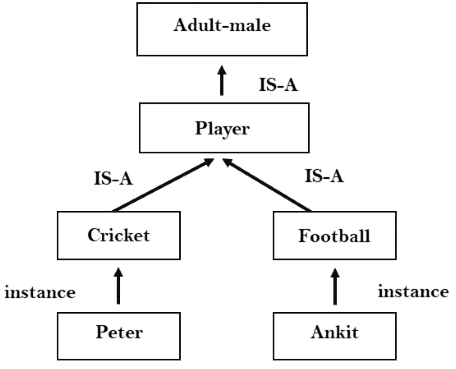Knowledge
What is knowledge representation?
Humans are best at understanding, reasoning, and interpreting knowledge. Human knows things, which is knowledge and as per their knowledge they perform various actions in the real world. But how machines do all these things comes under knowledge representation and reasoning. Hence we can describe Knowledge representation as following:
- Knowledge representation and reasoning (KR, KRR) is the part of Artificial intelligence which concerned with AI agents thinking and how thinking contributes to intelligent behavior of agents.
- It is responsible for representing information about the real world so that a computer can understand and can utilize this knowledge to solve the complex real world problems such as diagnosis a medical condition or communicating with humans in natural language.
- It is also a way which describes how we can represent knowledge in artificial intelligence. Knowledge representation is not just storing data into some database, but it also enables an intelligent machine to learn from that knowledge and experiences so that it can behave intelligently like a human.
What to Represent:
Following are the kind of knowledge which needs to be represented in AI systems:
- Object: All the facts about objects in our world domain. E.g., Guitars contains strings, trumpets are brass instruments.
- Events: Events are the actions which occur in our world.
- Performance: It describe behavior which involves knowledge about how to do things.
- Meta-knowledge: It is knowledge about what we know.
- Facts: Facts are the truths about the real world and what we represent.
- Knowledge-Base: The central component of the knowledge-based agents is the knowledge base. It is represented as KB. The Knowledgebase is a group of the Sentences (Here, sentences are used as a technical term and not identical with the English language).
Knowledge: Knowledge is awareness or familiarity gained by experiences of facts, data, and situations. Following are the types of knowledge in artificial intelligence:
Types of knowledge
Following are the various types of knowledge

1. Declarative Knowledge:
- Declarative knowledge is to know about something.
- It includes concepts, facts, and objects.
- It is also called descriptive knowledge and expressed in declarativesentences.
- It is simpler than procedural language.
2. Procedural Knowledge
- It is also known as imperative knowledge.
- Procedural knowledge is a type of knowledge which is responsible for knowing how to do something.
- It can be directly applied to any task.
- It includes rules, strategies, procedures, agendas, etc.
- Procedural knowledge depends on the task on which it can be applied.
3. Meta-knowledge:
- Knowledge about the other types of knowledge is called Meta-knowledge.
4. Heuristic knowledge:
- Heuristic knowledge is representing knowledge of some experts in a filed or subject.
- Heuristic knowledge is rules of thumb based on previous experiences, awareness of approaches, and which are good to work but not guaranteed.
5. Structural knowledge:
- Structural knowledge is basic knowledge to problem-solving.
- It describes relationships between various concepts such as kind of, part of, and grouping of something.
- It describes the relationship that exists between concepts or objects.
The relation between knowledge and intelligence:
Knowledge of real-worlds plays a vital role in intelligence and same for creating artificial intelligence. Knowledge plays an important role in demonstrating intelligent behavior in AI agents. An agent is only able to accurately act on some input when he has some knowledge or experience about that input.
Let's suppose if you met some person who is speaking in a language which you don't know, then how you will able to act on that. The same thing applies to the intelligent behavior of the agents.
As we can see in below diagram, there is one decision maker which act by sensing the environment and using knowledge. But if the knowledge part will not present then, it cannot display intelligent behavior.

AI knowledge cycle:
An Artificial intelligence system has the following components for displaying intelligent behavior:
- Perception
- Learning
- Knowledge Representation and Reasoning
- Planning
- Execution

The above diagram is showing how an AI system can interact with the real world and what components help it to show intelligence. AI system has Perception component by which it retrieves information from its environment. It can be visual, audio or another form of sensory input. The learning component is responsible for learning from data captured by Perception comportment. In the complete cycle, the main components are knowledge representation and Reasoning. These two components are involved in showing the intelligence in machine-like humans. These two components are independent with each other but also coupled together. The planning and execution depend on analysis of Knowledge representation and reasoning.
Approaches to knowledge representation:
There are mainly four approaches to knowledge representation, which are givenbelow:
1. Simple relational knowledge:
- It is the simplest way of storing facts which uses the relational method, and each fact about a set of the object is set out systematically in columns.
- This approach of knowledge representation is famous in database systems where the relationship between different entities is represented.
- This approach has little opportunity for inference.
Example: The following is the simple relational knowledge representation.
| Player | Weight | Age |
|---|---|---|
| Player1 | 65 | 23 |
| Player2 | 58 | 18 |
| Player3 | 75 | 24 |
2. Inheritable knowledge:
- In the inheritable knowledge approach, all data must be stored into a hierarchy of classes.
- All classes should be arranged in a generalized form or a hierarchal manner.
- In this approach, we apply inheritance property.
- Elements inherit values from other members of a class.
- This approach contains inheritable knowledge which shows a relation between instance and class, and it is called instance relation.
- Every individual frame can represent the collection of attributes and its value.
- In this approach, objects and values are represented in Boxed nodes.
- We use Arrows which point from objects to their values.
- Example:

3. Inferential knowledge:
- Inferential knowledge approach represents knowledge in the form of formal logics.
- This approach can be used to derive more facts.
- It guaranteed correctness.
- Example: Let's suppose there are two statements:
- Marcus is a man
- All men are mortal
Then it can represent as;
man(Marcus)
∀x = man (x) ----------> mortal (x)s
4. Procedural knowledge:
- Procedural knowledge approach uses small programs and codes which describes how to do specific things, and how to proceed.
- In this approach, one important rule is used which is If-Then rule.
- In this knowledge, we can use various coding languages such as LISP language and Prolog language.
- We can easily represent heuristic or domain-specific knowledge using this approach.
- But it is not necessary that we can represent all cases in this approach.
Requirements for knowledge Representation system:
A good knowledge representation system must possess the following properties.
- 1. Representational Accuracy:
KR system should have the ability to represent all kind of required knowledge. - 2. Inferential Adequacy:
KR system should have ability to manipulate the representational structures to produce new knowledge corresponding to existing structure. - 3. Inferential Efficiency:
The ability to direct the inferential knowledge mechanism into the most productive directions by storing appropriate guides. - 4. Acquisitional efficiency- The ability to acquire the new knowledge easily using automatic methods.